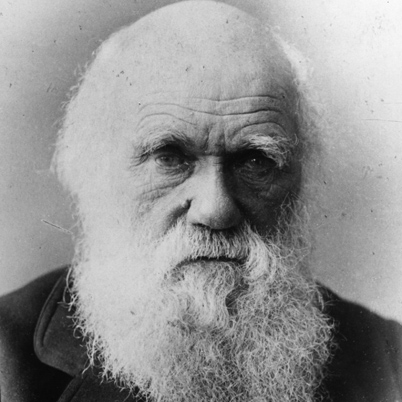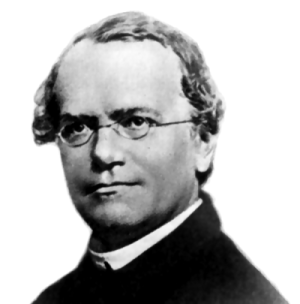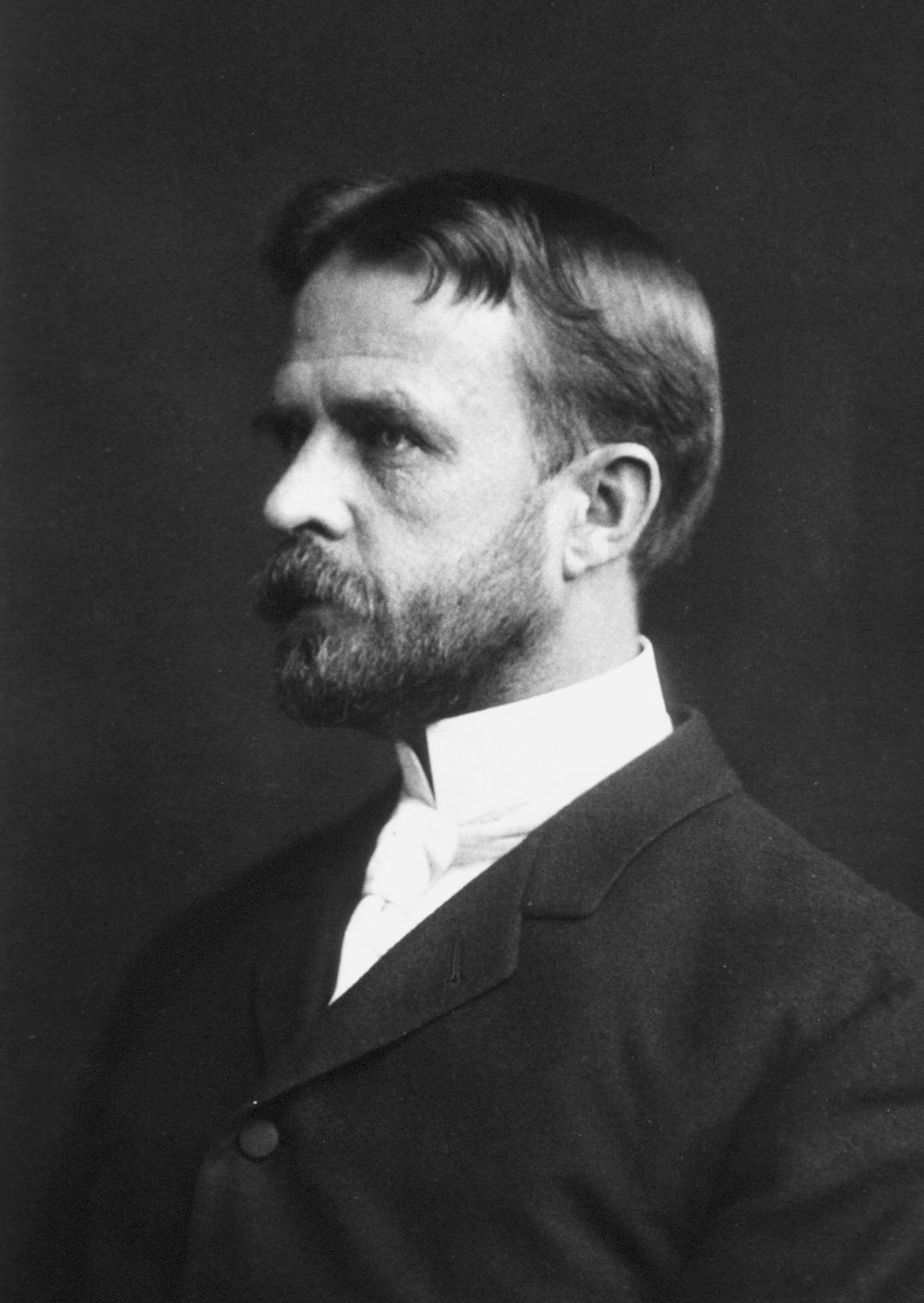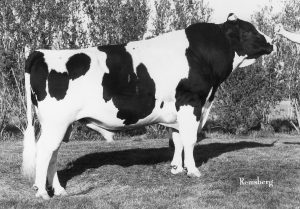
Round Oak Rag Apple Elevation
Breeding a legendary dairy sire isn’t automatic. It is not as simple as crossing the right sire with the right dam. However, although it isn’t easy, it does happen.
In one of the most famous cases of all, that of Round Oak Rag Apple Elevation, it is somewhat surprising that the tremendous impact that was to become legendary was not immediately obvious.
It took a little time for the world to recognise his greatness. But, in the end, Round Oak Rag Apple Elevation changed an entire breed and the dairy industry.
The Breeding of Elevation was Far from a Sure Thing
It would take time for the world to recognize the presence of greatness. Elevation was the product of a great mother, Eve, and a questionable father, Tidy Burke. As it happens, Elevation brought together the best from the Burkes, Rag Apples, Triunes and Winterthur bloodlines. That is one of the reasons why Elevation would never have been totally missed. Furthermore, Elevation did many important things well. There are five that stand out: 1. Production 2. Udders 3. Mobility 4. Fertility and 5. Longevity. Measuring any one or all of these traits shows you what made Elevation special, for these are just a few of the characteristics that contributed to his popularity. However, Elevation went way beyond mere popularity. This legendary bull made a tremendous impact on the genetics of the Holstein Breed. He changed dairy organizations. He affected dairy breeding around the world. The fact that Elevation has 10,000 registered sons in the United States alone speaks volume to both his acceptance and impact.
Was Elevation a Product of Genomics or Ahead of Genomic Times?
Today Elevation would have had hair pulled and submitted to DNA testing. But in the 1960’s, if you can imagine it, here was a bull entering a sampling program from a slow maturing mother and a never classified father. A father who physically significantly lacked both size and mobility.
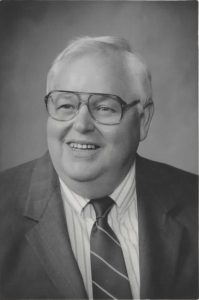
George Miller
The mating that resulted in Elevation used the combined knowledge and ‘go for it’ attitude of two men: breeder, Ron Hope from Virginia and his advisor, George Miller. These two were first cousins, and they started three generations back to produce Elevation. That is the way it was done in those days. To arrive at Elevation’s dam, Eve, Hope and Miller stacked three sires: Ivanhoe, Gaiety and General.
By the way, in her early life, Eve carried more condition than normal. This is something that is also seen in Elevation daughters.
It is not any wonder, therefore, that Elevation passed on good fertility, given what we know today about the positive correlation between fertility and body condition score.
After completing a Master of Science degree at Virginia Tech, George Miller spent his career in A.I. starting at the field level, then as a state A.I. manager and eventually as Director of Marketing and Development at Select Sires. George knew Holsteins, and he had access to bull performance information. There must have been many interesting discussions between these first cousins about who would be the best mate for Eve, in order to produce a son that could enter A.I.
As mentioned previously, Tidy Burke Elevation, Elevation’s sire, was an ugly duckling but he did produce outstanding daughters. Four of those daughters earned Honorable Mention All-American Get of Sire. Today, it is evident that an artful breeder and a top notch A.I. man were indeed able to find the best sire available for Eve. Remember that these men were making their decisions before the world had ever thought of using DNA information to aid in mating.
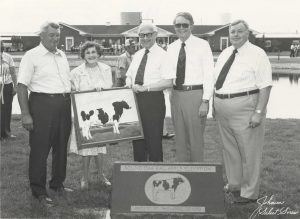 Elevation Made an Impact on Organisations
Elevation Made an Impact on Organisations
Charlie Will, who is the Holstein Sire Program Manager at Select Sires, gives perspective to the impact that Elevation has had on the company that originally purchased him. “Elevation put Select Sires on the map. He was so far ahead of all other bulls for his time. He had exceptional production and amazing type at the same time.” He explains what that meant over time, from the beginning and up to and including the present time. “Elevation made it possible for Select sires to grow as a new company. Today Elevation still ranks #1 at Holstein USA for the most genes in common among today’s active proven sires (14.5%). His impact continues 52 years after his birth.”
The WOW Factor of Elevation.
It’s easy to reiterate what set Elevation apart from the competition. Charlie keeps it simple. “Elevation had extraordinary type and production in one package.” He sees this combination as almost miraculous. “he dominated the mating no matter what kind of cow you used him on. He could make a Great Cow from a Poor dam. This is why he could have a huge impact in a single generation.”
Elevation Didn’t Just INFLUENCE the Future, He MADE the Future!
Breeders always pay attention to cow families. But in order to influence an entire population, you must go beyond sires and look at their descendants. Elevation influenced one generation after another: his kids, his kid’s kids, his kid’s kid’s kids. This is what made Elevation’s influence stellar.
Facts Alone Don’t Spark Legends. Results Do.
In any business, repeatable results are the only true measure of legendary success. Popularity and memories fade. In dairy cattle breeding, generations of descendants tell the real story.

Charlie Will
Holstein Sire Program Manager
Select Sires
In describing Elevation daughters, Charlie Will starts with a somewhat modest description. “His daughters had great legs and feet. A straighter leg but with healthy hocks and strong loins.” Warming to the topic, Charlie adds “Elevation daughters are tall enough, but not extreme, with ideal dairy strength and proportional width for the stature.” He concludes with what made the difference. “The typical Elevation daughters were short headed heifers but, when they were called into line, their exceptional udders, high and wide Rear Udder, and the great shape and symmetry of their udders, quickly made a breeder proud to own her.”
The first appearance was not always the final answer with Elevation daughters that became long- lived high production cows.
Once proven, everyone recognized that Elevation would continue stamping out great daughters, as he moved the Holstein breed to new heights.
Elevation’s Legacy Lives on Through His Sons and Daughters
Since almost all sires active in the breed today trace back to Elevation, Charlie Will finds it hard to pick from a list where the greats are almost too numerous to mention. For him, Elevation’s most impact sons include, “Bova, Starbuck, Pete, Mars Tony, Sexation, and Lime Hollow Mars.”
On the daughter side, Charlie lists many attributes. “Elevation has had many class winning daughters, including at World Dairy Expo and the Royal Winter. Elevation also led the list, at one time, for the number of Excellent daughters and also for the number of daughters who scored 95, 96 and 97.” His daughter list reads like an all-star lineup, from EX97 All-Time All-American’s Ella and Twinkie to EX-GMD Cora and Lindy, the dams of Carnation Counselor and Townson Lindy, respectively.
Elevation Surpasses All Heights
When we recognize a dairy legend, it is great to hear some stories from behind the scenes. Charlie tells one about the time that Elevation was classified 96. “Jim Patterson was head of the Holstein USA classification program at the time that Elevation was raised from 95 to 96. Later, after he retired, he told me that he only made one mistake, in all the years that he classified. He wished that he would have made Elevation 97 instead of 96!” (Learn more: CHARLIE WILL “A CAREER WITH IMPACT” – SELECT SIRES 50TH ANNIVERSARY)

Northcroft Ella Elevation EX-97-4E
1980 – Grand/Supreme Champion – WDE
1981 – Grand Champion – RAWF
1977, 1980, 1981, 1982 – All-American
Elevation’s Impact is Felt
With the perfect vision accorded to us by hindsight, we can clearly see that Elevation didn’t only influence genetics. Elevation has also had a tremendous impact on sales, new research and the success of countless breeders and organisations. Dairy strategy and development have also felt his influence. And, ultimately, the dairy show ring was also impacted by Elevation.
The World Wide Elevation Influence
Elevation, often known as RORAE, made friends for United States Holsteins around the world. Therein lies the engine that drives the legend. Fundamentally, around the world, one bull, through his progeny, significantly changed the profitability of the Holstein cow. But the measure of Elevation goes beyond mere financial success. Elevation made many dairymen into successful dairy breeders. How did he do it? Elevation stamped out daughters that provided what dairymen needed. Production. Longevity. Fertility. Mobility. Functional mammary systems. These are the characteristics passed on by a one-of-a-kind, legendary bull.
The Bullvine Bottom Line
Elevation forever lifted the worldwide dairy breeding industry to a new level.
Greatness can have many definitions, but in Holstein breeding, it can be said using a single name, Round Oak Rag Apple ELEVATION.

Get original “Bullvine” content sent straight to your email inbox for free.





